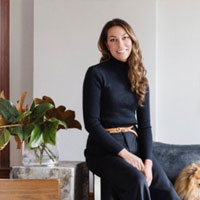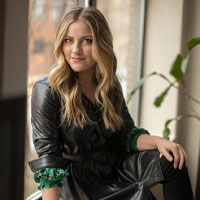Should a sofa face the door? Experts reveal how you can achieve the perfect placement
Does it matter if a sofa faces the door? Designers share their advice for choosing the best spot for your sofa


A sofa is often the largest piece of furniture in a living room, with its placement having a big impact on the overall design, layout and feel of the space.
When exploring where to put a sofa, many of us only have a handful of options to choose from, but should we be avoiding placing a sofa in front of a door for successful feng shui furniture placement? We speak to the designers in the know.
Can a sofa face the door? Experts help you decide
In short, yes, a sofa can face the door, sometimes that may be the only viable option for your living room layout ideas – for example, preventing a sofa from facing the door in a small living room with limited space may lead to an awkward layout that makes no sense.
The perfect sofa placement can vary depending on the size of your living room and the overall layout and design you are trying to create. So, to help you make the right design decision for the sofa in your living room (door-facing or not) we have spoken with a collection of interior designers who share their top tips for finding the perfect placement.
1. Position your sofa against the longest wall in the room

'Many sofas are placed in front of the longest wall in the room,' says Paul Fleming from Fleming and Howland. As one of the most common areas to place a sofa, this positioning usually results in a door being at the side or in front of the sofa – but usually not direct facing. Paul continues, 'while a door might be in your eyeline from the sofa in this spot, few actually choose to place their sofa directly opposite a door with nothing else in between.'
Furniture designer and founder of MENO Home, Jerri Hobdy, also adds, 'generally if a sofa is a lower back and more contemporary, it may work well being floated in the space, and if it is a more traditional, upright and high-backed sofa, you may consider placing it along a wall to make sure you are not creating awkward levels within the room.'
If you're placing your sofa against the longest wall in the room, or by the wall where there are no architectural interruptions from windows or fireplaces, aim to position it so the door is at the side of your eye-line, rather than directly across.
Design expertise in your inbox – from inspiring decorating ideas and beautiful celebrity homes to practical gardening advice and shopping round-ups.

Paul Fleming is the 7th Generation owner of Fleming & Howland, a centuries old furniture manufacturer based in the UK renowned for their beautiful sofa designs.

Denver-based furniture designer Jerri Hobdy is the founder of furniture label, MENO. Jerri previously worked as a product designer for Anthropologie, and has designed a large portion of the renowned brands unique furnishings.
2. Center your sofa around a focal point

'Sofas should never be placed facing the door, but rather be placed in a central location facing the focal point of the room. The focal point does not need to be a TV, it could be a fireplace, a beautiful window with a view, or a stunning piece of artwork. Having the sofa flow with your focal point will create a more visually appealing and functional space,' advises Alyssa Hall, lead designer at Donna Mondi Interior Design.
This placement can work well in both small and large living rooms, one sofa can be placed directly in front of a focal point, such as a TV or fireplace, as shown in this gray living room designed by Kimberley Harrison Interiors, or multiple sofas and seats can face one another surrounding the focal point; establishing an intimate and engaging seat space.
AP8 Guy Bourdin framed print | $1,865 at Net-A-Porter
Dramatize your walls with a piece of art that provides a striking design statement.

Alyssa Hall is a lead interior designer at Donna Mondi Interiors, an award-winning design firm with locations in Chicago and Denver.
3. Evaluate the room's layout

'The only instance a sofa should face the door is in a small room. This is a simple way to effectively space plan the layout to ensure there is good flow within a small space,' says interior designer, Alyssa Hall.
If you're working with a small living room layout, London-based interior designer, Benjamin Ibanez advises, 'small room layouts often mean that your sofa will have to face the door, but this doesn't have to detract from the space. It simply means you have to pick the right size and type of sofa and be very specific about its positioning. A good option if you have the space is an L-shaped sofa, as this means you can make use of two walls and create an area within the room. You can then enhance this design with an area rug pushed up against the sofa to clearly divide the living room.'
In a larger living room, to help the space feel more snug, it is often advised to move your furniture away from the walls, and establish a seating zone in the center of the larger room (or around a focal point). This well help create a cozy seat space, and can divide the larger area into smaller, more inviting sections.

Benjamin Ibanez is a senior interior designer at FCI Interior Design, an award-winning design firm based in London. Originally hailing from Spain, Ben manages design projects around the globe, including the US, UAE, India and Africa.
4. Determine the functionality of the room

NYC-based interior designer, Isfira Jensen says, 'when it comes to determining the layout of furnishings, specifically a sofa, the main consideration should be how the sofa (and the room) is intended to be used.
'If the space will be used primarily for entertaining guests, facing the sofa towards the door will create an inviting and welcoming atmosphere. However, if the intent is to use the room for relaxation or watching TV, facing it away from the door and towards the TV, can help create a more private and comfortable environment.'
We all use our homes differently, and thinking carefully about the room in which your sofa will be used day in and day out, as well as what other furniture will be placed in the space, will help you decide on the best spot and most functional layout.

Interior Designer Isfira Jensen is the CEO and principal designer of NYC-based design firm, Nufacet Interiors.
5. Assess the overall balance and flow of the room

When creating a successful design, their are many design principles that interior designers follow to establish a harmonious and well-thought out scheme, such as balance, rhythm, repetition and symmetry.
Balance refers to distributing the right visual weight around the room, this can be everything from furniture to paint ideas, lighting and accessories, and is a principle used to help to guide the eye around the room, ensuring there is a good sense of flow.
As interior designer, Alyssa Hall says, 'the sofa should be placed in a way that balances the room and creates a good flow of traffic. Avoid placing it in a way that blocks any natural paths or creates awkward angles.'
When deciding on your sofa position, it is important to bear these principles in mind, and assess how the sofa works with the other design elements in the room.
Interior designer, Isfira Jensen also supports this and says, 'special consideration should always be given to traffic flow in a room when space planning. If the sofa faces the door yet blocks the flow of traffic, making it difficult for people to move around the room comfortably, it's likely better to place the sofa against a wall.'
FAQs
Is it okay to put a sofa in front of a window?
It is often perceived that placing a sofa in front of a window is a design faux-pas, as the view from the window should be appreciated rather than ignored. However, as we have discussed, every space is different, and as Benjamin Ibanez explains, a sofa under a window can actually make for a successful room layout.
'If possible, the ideal placement of a sofa is with its back against the window. Not only do you negate any glare from the window while sitting on the sofa, but your sofa can really shine in the natural light. And don't worry about the light affecting the color or lifespan of your sofa, if you're investing in one of the best couches, is will be built to look fantastic throughout its lifetime.
If your living room opens up to a window at the back for example, placing your sofa underneath the window while facing the door makes the most sense, as this will draw the eye to the natural light source and the central seat space. To avoid blocking light from a low-set window, choose a low-profile sofa design.'
How do you place a couch for Feng Shui?
Feng shui in interior design refers to the ancient Chinese practice that roots itself in the philosophy of how arranged objects and certain colors can affect the overall harmony and balance of a room, with good feng shui establishing an overall positive and inviting energy in a space, also know as, Chi.
In terms of the right couch placement for successful feng shui, your sofa should be placed in a position that enhances the overall flow of the room, rather than acting as an obstacle.
It is also advised for harmonious feng shui that a couch is to be placed against a wall, helping to establish a more grounding, stable and supporting atmosphere.
Paul Flemming from Fleming and Howland concludes, 'it can be tricky to decide where the best placement for a sofa is in a room – with many debating whether a sofa can face the door. But overall, yes, a sofa can face the door, and it can actually offer a warm welcome, especially in small rooms.'
Whether you opt to have your sofa away from the door in a larger living room, or embrace a door-facing placement in a smaller space, as long as the placement works in harmony with the overall design and size of your space, that is all that matters.

Zara joined Homes & Gardens in February 2022 as a Content Editor. After studying English Literature at University, she worked as an Ecommerce Website Editor, Content Writer and Buying Intern at multiple independent businesses within the luxury retail and lifestyle sectors. Her role at Homes & Gardens unites her love, experience and passion for the world of design and desire to create inspiring written content. She enjoys nothing more than discovering new trends, brands and products, whether that be in fashion, interior design or lifestyle.
